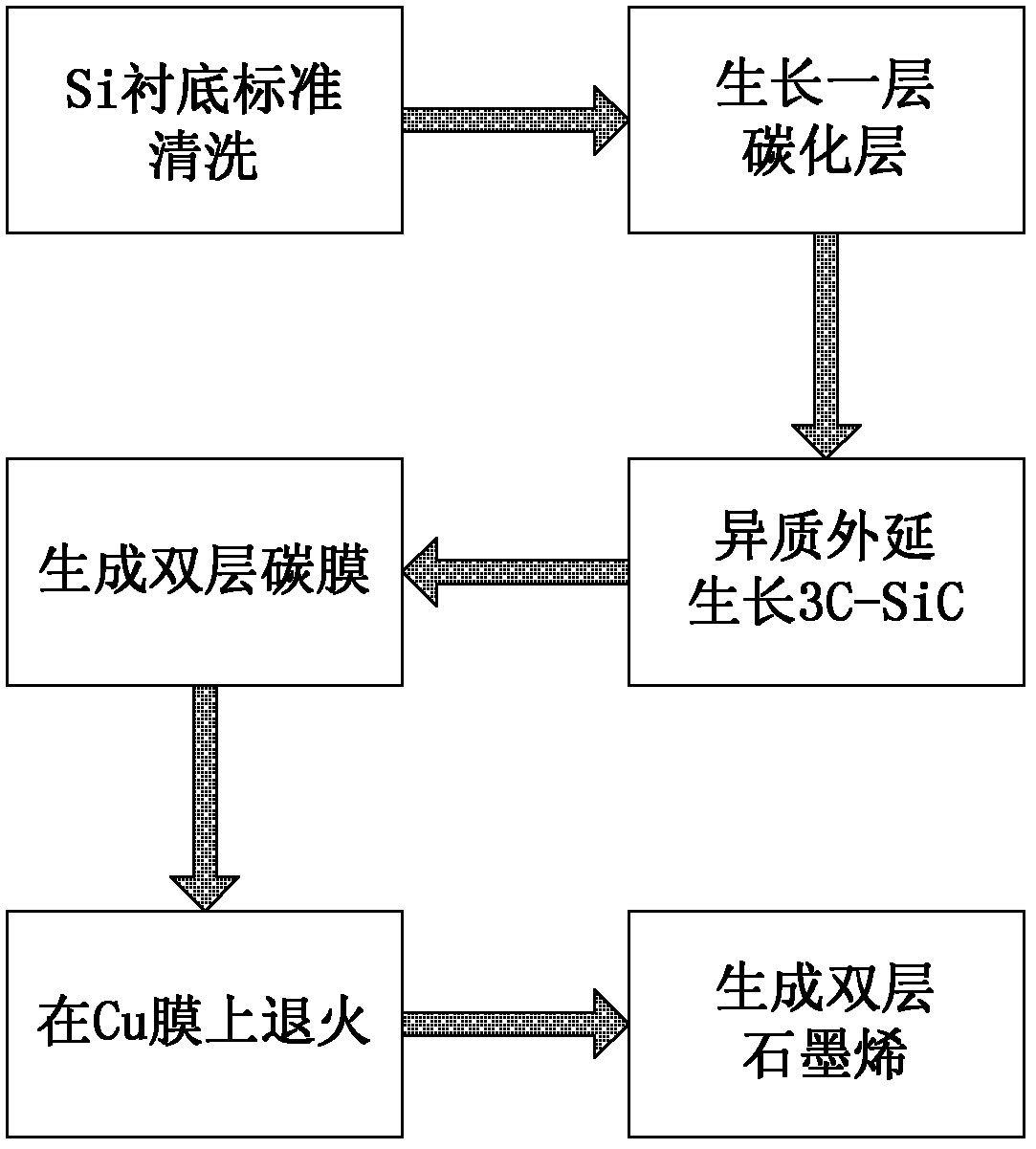Graphene preparation method based on Cu film assisted annealing
A graphene and annealing technology, applied in the field of microelectronics, can solve the problems of difficulty in manufacturing graphene, expensive single crystal SiC, uneven number of layers, etc., and achieve the effects of low porosity, smooth surface and good continuity
- Summary
- Abstract
- Description
- Claims
- Application Information
AI Technical Summary
Problems solved by technology
Method used
Image
Examples
Embodiment 1
[0024] Step 1: Remove sample surface contamination.
[0025] Clean the surface of the 4-inch Si substrate substrate, that is, use NH 4 OH+H 2 o 2 Soak the sample in the reagent for 10 minutes, take it out and dry it to remove the organic residue on the surface of the sample; then use HCl+H 2 o 2 The reagent soaked the sample for 10 minutes, took it out and dried it to remove ionic contamination.
[0026] Step 2: Put the Si substrate substrate into the reaction chamber of the CVD system, and evacuate the reaction chamber to 10 -7 mbar level.
[0027] Step 3: growing the carbonized layer.
[0028] in H 2 In the case of protection, the temperature of the reaction chamber is raised to the carbonization temperature of 900 ° C, and then the flow rate of 40 ml / min is introduced into the reaction chamber. 3 h 8 , grow a layer of carbonized layer on the Si substrate, the growth time is 8min.
[0029] Step 4: growing a 3C-SiC epitaxial film on the carbonized layer.
[0030] R...
Embodiment 2
[0043] Step 1: Remove sample surface pollutants.
[0044] Clean the surface of the 8-inch Si substrate substrate, that is, use NH 4 OH+H 2 o 2 Soak the sample in the reagent for 10 minutes, take it out and dry it to remove the organic residue on the surface of the sample; then use HCl+H 2 o 2 The reagent soaked the sample for 10 minutes, took it out and dried it to remove ionic contamination.
[0045] Step 2: Put the Si substrate substrate into the reaction chamber of the CVD system, and evacuate the reaction chamber to 10 -7 mbar level.
[0046] Step 3: growing a carbonized layer.
[0047] in H 2 In the case of protection, the temperature of the reaction chamber is raised to the carbonization temperature of 1000 ° C, and then the flow rate of 40ml / min is introduced into the reaction chamber. 3h 8 , grow a layer of carbonized layer on the Si substrate, the growth time is 6min.
[0048] Step 4: growing a 3C-SiC epitaxial film on the carbonized layer.
[0049] Rapidly...
Embodiment 3
[0057] Step A: Clean the surface of the 12-inch Si substrate, that is, use NH 4 OH+H 2 o 2 Soak the sample in the reagent for 10 minutes, take it out and dry it to remove the organic residue on the surface of the sample; then use HCl+H 2 o 2 The reagent soaked the sample for 10 minutes, took it out and dried it to remove ionic contamination.
[0058] Step B: Put the Si substrate substrate into the reaction chamber of the CVD system, and vacuumize the reaction chamber to 10 -7 mbar level.
[0059] Step C: In H 2 In the case of protection, the temperature of the reaction chamber is raised to the carbonization temperature of 1100 ° C, and then the flow rate of 40ml / min is introduced into the reaction chamber. 3 h 8 , for 3 min to grow a carbonized layer on the Si substrate.
[0060] Step D: Rapidly raise the temperature of the reaction chamber to the growth temperature of 1250°C, and feed the SiH with flow rates of 35ml / min and 70ml / min respectively. 4 and C 3 h 8 , to...
PUM
| Property | Measurement | Unit |
|---|---|---|
| thickness | aaaaa | aaaaa |
Abstract
Description
Claims
Application Information
 Login to View More
Login to View More - R&D
- Intellectual Property
- Life Sciences
- Materials
- Tech Scout
- Unparalleled Data Quality
- Higher Quality Content
- 60% Fewer Hallucinations
Browse by: Latest US Patents, China's latest patents, Technical Efficacy Thesaurus, Application Domain, Technology Topic, Popular Technical Reports.
© 2025 PatSnap. All rights reserved.Legal|Privacy policy|Modern Slavery Act Transparency Statement|Sitemap|About US| Contact US: help@patsnap.com



